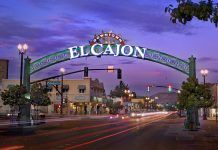On Feb. 8, the El Cajon City Council unanimously voted to stay with its current district map that was adopted in 2017 with data from the 2010 census. The city’s demographer, National Demographic Corporation, analyzed the 2020 census data against the current district map and found that the district remained balanced under the equal population requirements of the Voting Rights Act.
The Fair Maps Act specifies that the following prioritized criteria must be met: the map must comply with the Voting Rights Act and its equal population requirement, it is geographically contiguous, made up of undivided neighborhoods of interest, has easily identifiable boundaries, and it is compact.
At the Redistricting Hearing held Jan.22, 2022, after consideration of the 13 maps submitted for its consideration, the City Council voted to select the existing district map for approval at this Council meeting. If approved after first reading and introduction, the ordinance will return for adoption at the Feb. 22, 2022, council meeting. This came after Council changed course in adopting the original map at its Oct. 26, 2020, meeting and approved $20,000 for additional demographic services on Nov. 9, 2020.
City Manager Graham Mitchell said staff recommended adopting public map 100 after the city’s efforts to engage its “wonderfully diverse community.” He said the current map meets all the requirements established by the federal Voting Rights Act and California’s Fair Maps Act. Mitchell said not only did the city meet the requirements of the Fair Maps Act, but exceeded it, in encouraging participation throughout the redistricting process. He said the city began working on the process in July 2020, well before many other cities.
“This has allowed for a broader research effort of public participation throughout the process,” he said.
During public comment, Majdal Center Advocacy Coordinator Yasmeen Obeid said it has been mapping its community for more than eight months and actively involved in the redistricting process.
“By choosing the existing council district map rather than the 12 other public submitted maps, you are not engaging in this process in a sincere way that adheres to community input, a requirement of the Fair Acts Map,” she said. “Map 112 is a community driven map that clearly defines the boundaries of the Arab community in El Cajon…The difference between Map 100, the current map, and Map 112, is that 112 has smaller population deviation. Map 112 is current, while Map 100 is outdated and 112 considers communities of interest, while 100 splits them.”
Obeid said that though several council members spoke about how they represent all communities, but in its efforts to reach out to them over the past few weeks, no one responded to their requests.
“That shows that you do not represent us unfortunately,” she said. “And it is very disappointing because we wanted to really engage with you during this process.”
Council member Steve Goble asked Obeid why she felt that her community felt excluded, and why it decided to hold a press conference about the El Cajon map, when the maps they submitted for both county and state were not chosen.
Obeid said the current map does not represent the communities that have settled in El Cajon after 2010, and that the focus on the meeting was related to El Cajon
Policy Associate Jeanine Erikat, Partnership for the Advancement of New Americans said with the series of questions asked by Goble, that it showed there was partisan interest in both the state and county level.
“We are here today to talk about the city of El Cajon, where we are residents, where we have our loved ones, where we have our people, and we do not have to answer questions regarding the county and the state,” she said.
“Throughout this process you have said you had concerns with Map 112,” she said. “A demographer and City Council should have worked together to incorporate and respect communities of interest. Instead, a demographer was hired to inspect city maps and just review the data. The maps inputted by the community were meant as a starting point for discussion for various communities of interest in El Cajon and how they could be mapped together. I want to remind you that we are representing hundreds of community members, it really feels like a sham process, when you stated upfront when I called back in November 2020, that the city does not want to engage in a redistricting process because your current map is fine. And after your community pressures you, you engage in a process that ends with the existing map and does not even try to draw a draft map that respects communities of interest that were submitted to the council. You do not have to choose Map 112, but there were 13 other maps that could have been modified.”
Erikat said it is “unfathomable” to think that a community has not changed in five years.
With 10 public speakers, several needing translations services supported Map 112, wanting to keep the Middle Eastern populations together due to the language spoken, the ESL and housing programs that are utilized by the community in integrating into American society while living in El Cajon.
Goble said it was unfortunate that people felt that council was splitting the Arab community. He said people that speak languages other than Spanish, Asian or English comprise of 20% of El Cajon.
“In District 4, the community map in 2017, which is the culture, language, country of origin is 34%,” he said. “So, very correctly, we did not split the Arab community. We actually fulfilled the spirit of the law in concentrating the Arab community in both Districts 2 and 4. District 2 is 28%…so I am not sure why there is a sentiment that we split the Arab community. I think we went to great efforts to give them a voice.”
Mayor Bill Wells said that the lack of the Chaldean community complaining about the map and saying that it is not representative of them says a lot to him.
“By far, that is the largest magnitude of Arabic speakers that we have in this area, and I know the Chaldean community pretty well, and they are not shy about speaking up when they feel they have been maltreated or maligned,” he said.














